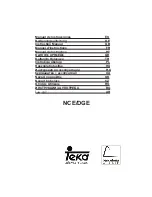
Dear client
Congratulations on your choice. We are sure that this
modern, functional and practical appliance, made with top
quality materials, will fully satisfy your needs.
Please read every section of this INSTRUCTIONS
MANUAL before using your kitchen hood for the first time,
to ensure maximum performance from the appliance and to
avoid breakdowns, which may be caused by incorrect use,
as well as to allow any minor problems to be solved.
To obtain optimum performance, the external conduct must
not be more than FOUR METRES long, have no more than
two 90° angles and its diameter must be at least Ø120.
• Please be aware of current local regulations with
reference to domestic electrical fittings and gas
eduction.
• Verify that the tension and frequency of the network
match those indicated on the label located inside the
kitchen hood.
• If the supply cable is damaged it should be replaced by
the manufacturer, the after-sales service or a suitably
qualified person in order to avoid hazard.
• Once the kitchen hood has been installed, ensure that
the mains cable to the network is not in contact with
sharp metal edges.
• The fumes should not be extracted through pipes that
are used to evacuate the fumes of gas (or another fuel)
operated devices.
• If the extractor fan is going to be used simultaneously
with equipment powered by a non-electric energy
source, e.g.: gas cookers, then the room must have
sufficient ventilation.
• Excessive fat accumulation in the kitchen hood and
metal filters is a fire risk and may also cause dripping,
therefore the inside of the kitchen hood and the metal
filters must be cleaned at least once a month.
• The lower part of the kitchen hood must be fitted
at least 65cm over gas or mixed hobs. FOLLOW THE
HOBS´ MANUFACTURER'S MINIMUM RECOMMEN-
DATIONS.
• Never leave gas hobs lit if not covered by a container.
The fat accumulated in the filters may drip or catch fire
when the temperature increases.
• Avoid cooking under the kitchen hood if the metal filters
are not fitted, e.g.: while they are being cleaned in the
dishwasher.
• You must not produce flames under the kitchen hood.
• Disconnect the appliance before any interior
manipulation, e.g. during cleaning or maintenance.
• We recommend the use of gloves and to be extremely
careful when cleaning the kitchen hood's interior.
• Your kitchen hood is designed for domestic use and
only for extraction and purification of fumes produced
during food preparation. It will be your responsibility if it
is used for other purposes, which may be dangerous.
The manufacturer cannot accept responsibility for
damage caused by improper use of the appliance.
• For repairs please contact the manufacturer’s nearest
Technical Assistance Service, and always use genuine
spare parts. Repairs or modifications carried out by
unqualified personnel can cause malfunctions or may
damage the appliance, putting your safety in danger.
• This appliance is marked according to the European
directive 2002/96/EC on “Waste Electrical and
Electronic Equipment” (WEEE). This guideline is the
frame of a European-wide validity of return and
recycling on Waste Electrical and Electronic
Equipment,
.
• This device is not meant to be used by persons
(including children) whose physical, sensory or mental
capacities
are
reduced,
or
who
lack
experience/knowledge, except if they have supervision
or received instructions for using the device by the
person responsible for his/her safety. Children should
not be allowed to play with the device.
Instructions for use
You may control the kitchen hood by operating the
controls as shown in the diagram.
Switch on the extractor fan a few minutes before you
start to cook in order to ensure that a steady air flow
has been established before fumes appear.
Allow the extractor fan to run for several minutes after
you have finished cooking (between 3 to 5 minutes) in
order to expel all the grease from the outlet duct. This
prevents the return of grease, smoke and smells.
Safety Instructions
GB
Summary of Contents for DBB
Page 2: ...MIN 650 345 200 210 NCE 59 mm DGE 69 mm 230 230 ...
Page 3: ...NCE DGE ...
Page 34: ...AR ...
Page 35: ...AR ...
Page 36: ......








































